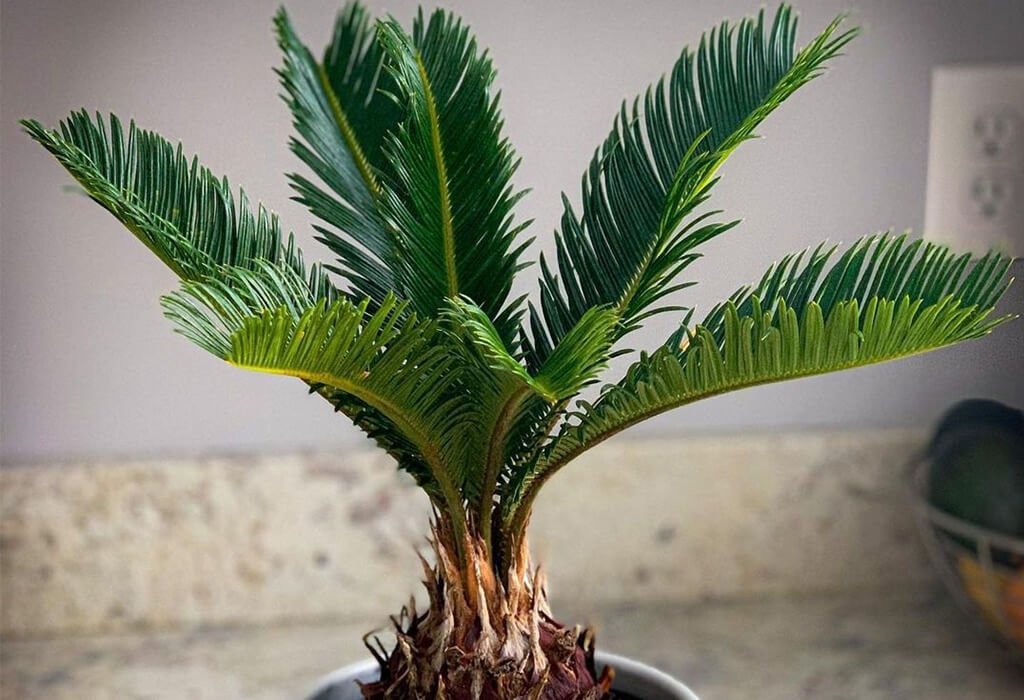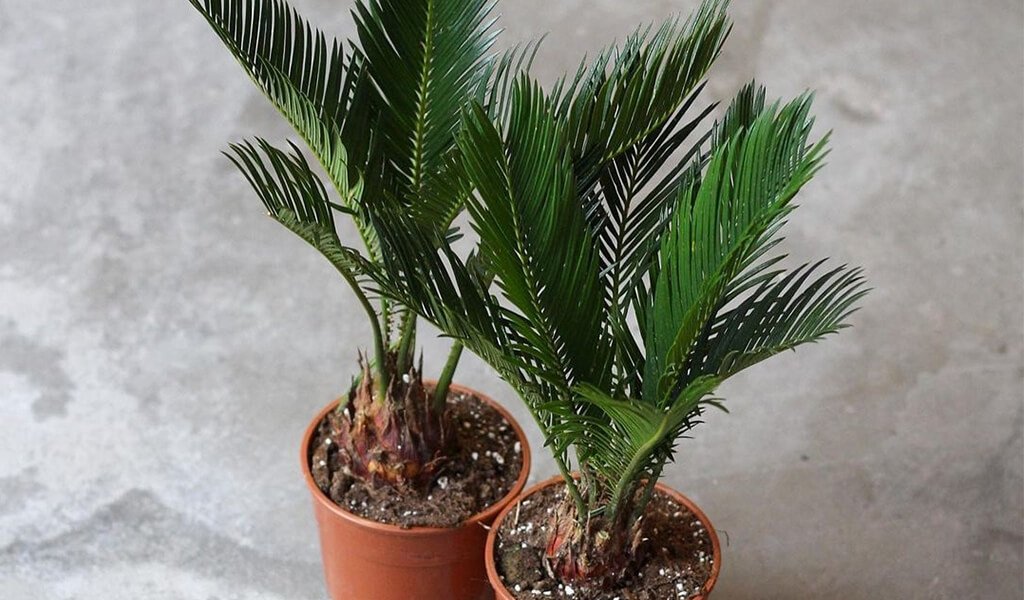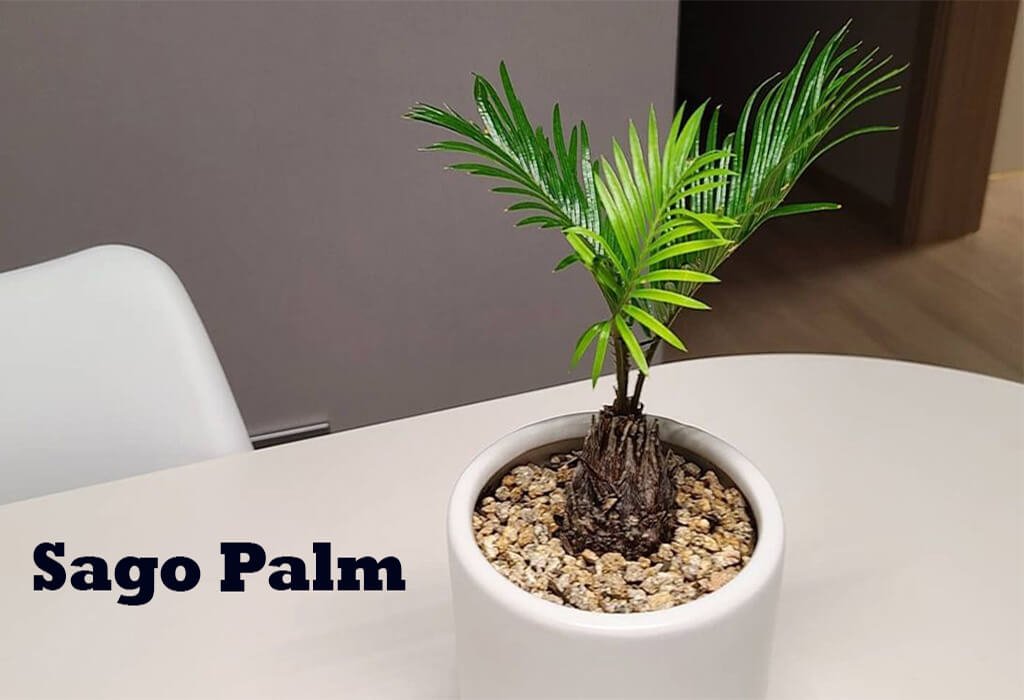Sago Palm Tree is a Monocarpic plant; it flowers just one occasion in its life and dies. Insects facilitate fertilizing the flowers. The fruits take 1–2 years to mature. Simply before the onset of flowering, the palm is harvested to get more yield. There’s an outsized range of air-purifying plants on this list permanently reason and also the Sago’s palm was an excellent plant for improving the air.
It attains a natural height of fifteen m. The stem is straight, stout, and, while not branches and contains a distinctive crown of huge pinnate leaves. The roots are unbranching and go straight down to the soil. Sago’s palm overgrows, and it dominates in tropical humate swamp rainforests, wherever different crop plants don’t thrive.
Sago palms are slow-growing and might be planted outside in hot climates or full-grown as houseplants. These fairly low-growing plants with long green fronds are cycads, a gaggle of ancient tropical and semitropical plants. Starch palms don’t seem to be troublesome to grow and maintain; however, they need specific growing conditions.
What is the Sago palm?
This can be a species of gymnosperm within the “Cycadaceae” family.
This may be a slow-growing, evergreen, long-lived, medium-sized palm-like plant.
This plant is local to southern Japan.
Scientific Name of Sago palm
The Scientific name of this plant is “Cycas revolute”.
History of Sago palm
This plant has begun within the zone expanding from Moluccas of Indonesia to New Guinea. Sago palm may be a tropical plant grown in Southeast Asia and Oceania, where it can outlive in a swampy peat environment. Sago palm could be a common title for a few plants which had been utilized to create Starchy nourishment.

Steps of Planting Sago palm
When to plant?
Plant your sago palm in early spring or late fall. This is the best time to plant sago palm.
Where to plant?
Sago palm issues are uncommon when they are appropriately put within the scene. We prescribe a developing location with full sun or fractional shade and fast-draining soil wealthy in humus.
What type of soil use in planting sago palm?
Sago’s palm likes Sandy, quick-draining soil. Moreover, you can make a preparing blend by combining 2 parts of preparing the soil, 1 portion of washed plant sand, and 1 portion of processed peat greenery. Include great quality compost to the soil beneath your sago palm each year or indeed twice a year.
What is the best situation to plant a sago palm?
Although sago palms can develop in complete sun introduction, they perform best in somewhat shaded regions. As well, much coordinate daylight can result in sunburnt foliage and plant stretch. Halfway shade moreover permits the takes off to develop bigger, coming about in a more excellent plant. Sago’s palm requires well-drained soil.
How much sun does Sago palm need?
Sago palms require 4 to 6 hours of daylight each day. They develop in full sun as well as fractional shade, and they do fine in shinning indoor regions with fair several hours of the day by day daylight exposure. It requires temperatures extending between 15 to 110 degrees Fahrenheit. Filtered daylight is best in hotter inland regions where the summer sun is more potent, even though they do best in full sun.
How big does sago palm grow?
It develops 15 feet tall and 12 feet wide with a swollen trunk 18 inches across.
How much water does keyword plant need?
The sago palm plant prefers dry soil to a persistently moist developing environment, so you should include a small amount of water. Water the sago palm each one to two weeks when the climate is dry, permitting the soil to dry out between each water system. If you bring your holder inside for the winter, you should moderate down watering impressively once every 2 weeks have to be sufficient.
In which country sago palms grow most?
Sago plant grows most in Japan.
How quick do Sago palms grow?
Sago palms develop exceptionally gradually. Inside, a two-year ancient plant will fair fit into a 5-inch pot. Since the roots are pot-bound, this will keep the development rate exceptionally moderate. Outside, it can take 50 a long time or so for a developed plant to reach a 10 to 12 feet tall stature.

How does Sago palm plant Grow?
- Choose a pot with drainage holes. For planting, 1st take the seeds from a sago palm.
- Mix your regular potting soil with lots of grit like pumice stone, sand, or moss. And add potting combine in the pot.
- Plant the starchy seed into a shallow space in instrumentation or pot.
- Arrange the sago palm seeds within the receptacle horizontally. Next, cowl the seeds with a sandy primarily based seed beginning combine.
- Place the pot in a scorching location inside. Do not place the pot or instrumentation below 70F.
- Keep the receptacle systematically dumps.
- After two months, it’ll begin to grow.
Sago palm Maintenance and Care
Watering:
The soil ought to dry out nearly thoroughly between every watering. it is Watering once the top four inches of soil dries out. If the sago is in a very relaxed atmosphere out of direct daylight, it’ll like less frequent watering for plants growing full sun and dry indoor surroundings, water weekly.
When watering, it is essential to form positive the soil gets equally and damp. Water slowly on the top of the pot. If the leaves begin turning yellow, the sago plant is also affected by over-watering or insufficient evacuation.
Fertilizing:
Fertilize your sago palms thrice each year, once in early April, once in early June, and once more in early August. You got to use additional fertilizer on sandy soils and others that drain quickly and less plant food on clay soils. Liquid fertilizer may be a good selection. Use a slow-release fertilizer 2 to a few times throughout the growing season.
Pruning:
Prune mature sago palms annually to eliminate yellow-tipped, aging foliage. Remember to wear gardening gloves once you do this. The most exact time to chop back your sago palm is throughout the fall. In pruning solely, take away utterly dead, badly broken, or unhealthy foliage. If desired, the fruit and flower stalks are often cropped moreover.
Cut the oldest and lowest levels as near to the trunk as attainable. Cutting the green fronds will weaken the plant, creating a lot of prone to pests and diseases. To improve the plant’s design, you will conjointly prefer to carefully cut away withered fruit and flower stalks at the tip of the season.
Temperature:
Sago palms aren’t tolerant of temperature reduction conditions. They are doing fine in bright indoor areas with simply some hours of daily daylight exposure. Partial shade additionally permits the leaves to grow larger.
They will face up to short periods of temperatures as low as fifteen degree; however are killed at 23 F or below. Out of doors, sago palm plants are simple to grow and have a slow rate of growth that produces them excellent instrumentality plants. In summer, you’ll bring your Sago palm outside till cold temperatures arrive.
Humidity:
Sago Palms will survive in basic house wetness; however, won’t grow further. Sago Palms like high wetness thus, you got to place a humidifier close to the palm if the air in your house is terribly dry.
Toxicity:
All components of the plant are toxic. Sago Palm is extraordinarily toxic to humans and animals if eaten. Sago palm is understood to be toxic. Intake of sago before the correct process to get rid of toxins will cause puking, liver injury, and even death. Recent proof indicates that the toxins have toxin effects, and currently, it’s thought about to be a slow poison.
Winter care:
However, keep the plant moderately damp; however, don’t provide it the maximum amount wet as you are doing in the summer. Covering the plant with a bag or lightweight blanket could be a great way of providing sago palm winter protection. Place the sago palm out the house in the day; thus, it got some quantity of sunlight. Throughout the winter, reduce watering.
Protect against Pests and Disease
Fungal infection:
If leaf edges flip yellow, tan or Venetian red, your tree is also plagued by plant unwellness. For protection, take away and destroy affected growth and keep the area below the tree clean and freed from plant rubbish.
Root rot:
This unwellness can retard plant growth, cause die-back or maybe kill the plant. A method to identify the fungus genus wellness appear in a dark vertical stain or sore on the trunk, presumably with black or red-black oozing sap. For protection, you plant your sago palm in bright exhausting soil and don’t overwrite it.
Insects:
Insects usually seem like little helmets or white waxy spots. The insects live within sago plant structures. Insecticidal soaps and delicate alcohol solutions are beneficial for stopping it.
Bacteria:
The bacteria causes yellow or brown leaves and plant death that begins with infection through plant wounds throughout wet weather. This disease causes ugly galls and plant disease on stems, bark and leaves. For protection, easy sanitation and take away or destroy infected plants, avoid overhead watering and soak pruning tools in disinfectant.
Mealy bugs:
Mealy bugs are tiny, soft-bodied pests. Because of this poor growth, premature leaf drop, twig plant disease. For protection, Wash overrun plants with a water hose. The water pressure can force the mealy bugs of the plant. Repeat the method every few days as required.

Uses of Sago palm
It is used in various food things.
- Sago palm is accustomed tp stiffen garment material within the textile trade.
- Sago is widely used to turn out starch pearls.
- Sago palm is widely used as ceremonial palms and in gardening.
- Sago palm is employed in creating starch.
- Sago creating the starch will be held on for exceptionally long.
Interesting Facts
- The sago palm will reach heights of up to fifteen feet in fifty years. Leaves are pinnately compound, four to five feet long, and up to nine inches wide.
- The sago palm was an excellent plant to clean up the air.
- This is an excellent plant for beginners.
- It will take fifty years approximately, for a mature plant to achieve ten to twelve feet tall heights.
- Long-lived starch palms will live to be over a hundred years previous.
- Sago Palm is extraordinarily toxic to humans and animals.
- It helps to forestall digestion problems, relieves gas, bloating and constipation.
- Sago provides antioxidants and resistant starch, and it’s going to be connected to health edges, together with reducing your risk factors for heart disease.
- Sago Pearls combined with oil will enhance the expansion of hair.
- It contains an honest quantity of dietary fiber that conjointly helps to rebalance the healthy gut bacterium.
Questions Related to Cycas revolute Plant
1. Do sago palms grow best in pots?
Sago palms grow slowly and like to be slightly root-bound; thus it is best to decide on a somewhat comfortable path for growing them. A pot that is no quite two or three inches larger than the bottom of the sago palm is best since it’ll allow the event of the plant’s root age while not being too outsized.
2.How much water do sago palms want in the growing season?
During the season, they have moderate watering. If the weather is dry, the plants ought to be patterned deeply all to 2 weeks.
3.Which part of a sago palm has poisonous?
All components of the sago Palm are toxic; however the seeds (nuts) are the foremost toxic to pets and are easier for them to eat than the prickly fronds.
4.Can sago palms grow indoors?
Sago palms are slow-growing plants that take a good few years to succeed in their most height of approximately 2ft, once fully grown inside. You got to give lots of bright, lightweight, on top of average wetness levels, don’t over-water and have lots of patience with a young plant.
5.Does sago palm spread?
Yes, but not much
Have some questions or suggestions? Use our comments section on this blog! You can feel free to leave a comment or two down below and we’ll get back to you as soon as possible!
We love reading your messages……

